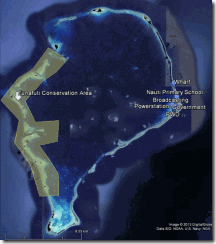A tour to Fualopa, an islet within Funafuti’s conservation area was part of the Fisheries’ department’s role played in World Environment Day 2017. The visit was organised as an awareness activity to link to the World Environment Day theme on “Connecting People to Nature”. The Funafuti Conservation Area (FCA), a marine protected area, extends from the northern centre of the channel between Tepuka and Tepukavilivili to a position about 1.11 km south of Tefala islet on the western side of Funafuti Atoll. The area under conservation extends between the 30m depth contour on the eastern side in the lagoon and the 20m depth contour west along the ocean side. The FCA occupies a total area of approximately 33km2 of the western reef margin, including six small islets. The Funafuti Conservation Area FCA was first established in 1997 and went into force under the Funafuti Conservation Area Act on the 1st of December 1999. This is a vital component of fisheries management and biodiversity for the atoll, helping to guarantee the resilience of the marine resources and habitats, and the sustainable utilisation of those resources in areas outside the conservation area by acting as a breeding refuge. In addition overflow of adult fishes that swim out of the conservation area add to the catchable resource in other parts of the atoll.
The Fisheries Department organised a field trip for Form 2 students from the Nauti and Seventh Day Adventist Primary schools. There were 52 people participating overall, including the pupils, teachers, Environment Day Committee, and some Fisheries staff. The visit took place on Friday the 9th of June 2017, starting at 8:00 in the morning with boats leaving from the main wharf and heading out to Fualopa islet. An awareness activity took place at Fualopa to all who attended the field trip. It started out with a brief lecture on what a Marine Protected Area is, why is it important to protect our maritime resources, information in the form of a map of the FCA and a brief account of its formation. Penalties for people who poach the FCA were also discussed. Fisheries officers also explained the food chain of the marine resources by showing pictures and how we humans connect to the resources. The study trip was unbelievably fun and enjoyed by the school kids and there was a strong sense of discovery. Students asked many questions and recorded their thoughts for later sharing in their households and at school. The field trip ended with a drive around the islet of Fualopa before heading home.
This activity was fully funded by the World Bank Pacific Regional Oceanscape Programme (PROP).
